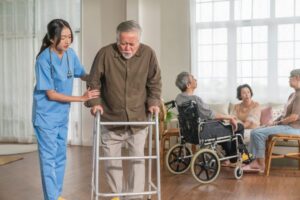
While putting our loved ones in nursing homes, we do not anticipate danger lurking around the corner. But the real picture may not necessarily be like this.
Slip and fall accidents have become a rampant issue in nursing homes. It poses a significant danger to the health and well-being of our loved ones. Falls in nursing homes can lead to severe injuries, emotional trauma, and, if care is not taken, even death.
This article discusses the common causes of slip and fall accidents and the actions one could take to prevent these accidents.
Factors Causing Slip and Fall Accidents in Nursing Homes
Below are some of the causes of slip and fall accidents in nursing homes.
Wet floors
Slippery floors, especially wet floors, are one of the major causes of these mishaps. Water or cleaning solution on the floor can be a ticking time bomb. The effects range from fractures to head injuries.
Poor lighting
Another cause of slip and fall in nursing homes is lighting. Lack of sufficient light makes it challenging for the residents to navigate their way around the corridor or any area in the home. They might easily fall if they bump into barriers or obstacles, as they cannot see easily.
This is even more worrying for the elderly or those with eyesight issues or other such conditions.
Cluttered walkways
Stretchers and wires connected to different appliances, like electric cords for lights and other appliances and furniture, are some of the barriers that make it very hard for the residents to move around the nursing home.
For instance, a resident may need to get to the bathroom or respond to a call bell, and in the process, they may trip and sustain severe injuries.
Lack of Handrails
In a nursing home, every step and hallway should be equipped with handrails. They should be installed at the right height and should be sturdy enough to provide support.
When handrails are missing, it’s not just an inconvenience; it’s a serious safety issue. Residents might try to navigate a hallway or staircase without that extra support, and that’s where accidents can happen.
They could slip, lose their balance, or even fall, leading to injuries that could have been avoided with proper handrails in place.
Unstable furniture and equipment
Unsteady furniture and equipment are also considered to be one of the causes of falls. People will sit on them or use them for balance, and if they are not well placed, they can cause injuries.
Likewise, medical equipment like wheelchairs and walkers is prone to mechanical failure or misuse, and this results in injuries.
Inadequate staffing and training
Insufficient staff and poorly-trained help have also been seen to have a role in slip and fall accidents in nursing homes. Employees who are overworked, stressed, or underprepared may not be able to offer proper guidance or assistance to residents.
How to Prevent Slip and Fall Accidents
To prevent slip and fall accidents in nursing homes, consider the following measures:
- Maintain clean, clutter-free environments: Ensure hallways and common areas are free of obstacles and promptly clean up spills to prevent slipping hazards.
- Ensure proper lighting: Adequate lighting is essential, particularly in bathrooms and hallways, to reduce the risk of falls in dimly lit areas.
- Provide necessary mobility aids: Equip residents with walkers, canes, or other mobility aids and regularly inspect them for any signs of damage.
- Use non-slip flooring: Install non-slip mats or carpets in areas prone to wetness, such as bathrooms, to reduce the risk of slipping.
- Install handrails: Place handrails in hallways and bathrooms to provide residents with extra support while moving around.
- Train staff to recognize fall risks: Educate staff on identifying potential hazards and assisting residents with mobility issues.
- Conduct regular assessments: Frequently assess residents’ health and mobility to address any muscle weakness, balance issues, or other factors that could contribute to falls.
Conclusion
Fall accidents in nursing homes are an alarming issue that cannot be ignored. These risks need to be dealt with because our loved ones deserve a safe place to live and flourish. Eliminating risks in this way is important to prevent needless pain and make places safer for humanity.